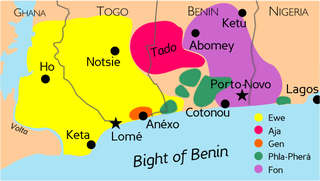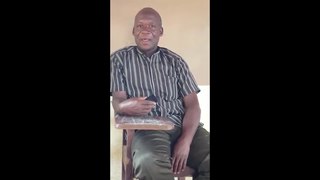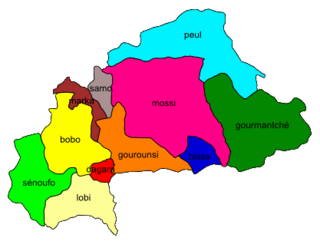
The Gur languages, also known as Central Gur or Mabia, belong to the Niger–Congo languages. There are about 70 languages belonging to this group. They are spoken in the Sahelian and savanna regions of West Africa, namely: in most areas of Burkina Faso, and in south-central Mali, northeastern Ivory Coast, the northern halves of Ghana and Togo, northwestern Benin, and southwestern Niger. Additionally, a single Gur language, Baatonum, is spoken in the extreme northwest of Nigeria.
Sranan Tongo is an English-based creole language that is spoken as a lingua franca by approximately 550,000 people in Suriname.
The Mande languages are spoken in several countries in West Africa by the Mandé peoples and include Maninka, Mandinka, Soninke, Bambara, Kpelle, Dioula, Bozo, Mende, Susu, and Vai. There are "60 to 75 languages spoken by 30 to 40 million people", chiefly in Burkina Faso, Mali, Senegal, the Gambia, Guinea, Guinea-Bissau, Sierra Leone, Liberia, and Ivory Coast, and also in northwestern Nigeria and northern Benin.

The Gbe languages form a cluster of about twenty related languages stretching across the area between eastern Ghana and western Nigeria. The total number of speakers of Gbe languages is between four and eight million. The most widely spoken Gbe language is Ewe, followed by Fon. The Gbe languages were traditionally placed in the Kwa branch of the Niger–Congo languages, but more recently have been classified as Volta–Niger languages. They include five major dialect clusters: Ewe, Fon, Aja, Gen (Mina), and Phla–Pherá.
Saramaccan is a creole language spoken by about 58,000 ethnic African people near the Saramacca and the upper Suriname River, as well as in Paramaribo, capital of Suriname. The language also has 25,000 speakers in French Guiana and 8,000 in the Netherlands. It has three main dialects. The speakers are mostly descendants of fugitive slaves who were native to West and Central Africa; they form a group called Saamacca, also spelled Saramaka.
The Adamawa languages are a putative family of 80–90 languages scattered across the Adamawa Plateau in central Africa, in Nigeria, Cameroon, Central African Republic, and Chad, spoken altogether by only one and a half million people. Joseph Greenberg classified them as one branch of the Adamawa–Ubangi family of Niger–Congo languages. They are among the least studied languages in Africa, and include many endangered languages; by far the largest is Mumuye, with 400,000 speakers. A couple of unclassified languages—notably Laal and Jalaa—are found along the fringes of the Adamawa area.
The Phla–Pherá (Xwla–Xwela) languages form a possible group of Gbe languages spoken mainly in southeastern and southwestern Benin; some communities are found in southeastern Togo and southwestern Nigeria. The group, comprising about ten varieties, was introduced by H.B. Capo in his 1988 classification of Gbe languages as one of the five main branches of Gbe. Additional research carried out by SIL International in the nineties corroborated many of Capo's findings and led to adjustment of some of his more tentative groupings; in particular, Phla–Pherá was divided in an eastern and a western cluster. Phla–Pherá is one of the smaller Gbe branches in terms of number of speakers. It is also the most linguistically diverse branch of Gbe, due partly to the existence of several geographically separated communities, but mainly because of considerable influence by several non-Gbe languages in the past. Some of the Phla–Pherá peoples are thought to be the original inhabitants of the region having intermingled with Gbe immigrants.

The Teda language, also known as Tedaga, is a Nilo-Saharan language spoken by the Teda, a northern subgroup of the Toubou people that inhabits southern Libya, northern Chad and eastern Niger.
The Bolgo language is a member of the Bua languages spoken in south-central Chad, in the villages of Koya, Boli, Gagne, and Bedi southeast of Melfi, by about 1,800 people. Speakers also make up the majority of the population of Sorki canton in Chinguil sub-prefecture.
Kabiye is an Eastern Gurunsi Gur language spoken primarily in northern Togo. Throughout the 20th century, there was extensive migration to the centre and south of Togo and also to Ghana and Benin. Kabiye speakers made up over 23% of the Togolese population in 1999.

Ghana is a multilingual country in which about eighty languages are spoken. Of these, English, which was inherited from the colonial era, is the official language and lingua franca. Of the languages indigenous to Ghana, Akan is the most widely spoken, precisely in the south. Followed by Dagbanli, the most widely spoken language in Northern Ghana.

There are over 525 native languages spoken in Nigeria. The official language of Nigeria is English, the language of former colonial British Nigeria. As reported in 2003, Nigerian English and Nigerian Pidgin were spoken as a second language by 60 million people in Nigeria. Communication in the English language is much more popular in the country's urban communities than it is in the rural areas, due to globalization.

Dan is a Mande language spoken primarily in Ivory Coast and Liberia. There is also a population of about 800 speakers in Guinea. Dan is a tonal language, with around 9-11 contour and register tones depending on the dialect.

Benin is a diverse country linguistically. A total of 55 languages are spoken in Benin, with 50 being indigenous. Of those, French is the official language, and all the indigenous languages are considered national languages.

Bissa, is the language spoken by the Bissa people, a Mande ethnic group of south-central Burkina Faso, northeastern Ghana, northwestern Nigeria, the northernmost tip of Togo and northern Benin. Alternate names for this language include Busansi which is used by the Mossi people or Busa which is used in Nigeria.
The Land Dayak languages are a group of dozen or so languages spoken by the Bidayuh Land Dayaks of Borneo.
Kei is an Austronesian language spoken in a small region of the Moluccas, a province of Indonesia.
Ifè is a Niger–Congo language spoken by some 180,000 people in Togo, Benin and Ghana. It is also known as Ana, Ana-Ifé, Anago, Baate and Ede Ife. It has a lexical similarity of 87%–91% with Ede Nago.
The Anii or Basila language is spoken in Benin, and central eastern Togo and central eastern Ghana. It is part of the geographic group of Ghana Togo Mountain languages of the Kwa branch of Niger–Congo.







